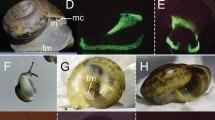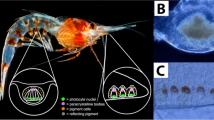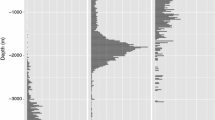Abstract
The luminous responses to electrical stimulation of isolated polyps of 4 deep-water anthozoans are described. All show facilitatory responses and summation at stimulus frequencies > 2 s−1. The responses of the gorgonian Acanella arbuscula comprise a slow summation of weak individual flashes. It is suggested that there is no fundamental difference between deep and shallow species, nor between the responses of scyphozoans, such as Pelagia and Atolla, and anthozoans, such as those described here. Both facilitated and decremental responses can be obtained from each of the 2 groups and the complexity of in vivo responses may be as much a reflection of selective pressures on the neural pathways as on the bioluminescent systems themselves.
Similar content being viewed by others
References
Bilbaut, A., 1975a. Étude de la bioluminescence chez l'octo-Veretillum cynomorium (Pall.). 1. Les réponses lumineuses des autozoides isolés de la colonie. Arch. Zool. exp. gén. 116: 27–42.
Bilbaut, A., 1975b. Étude de la bioluminescence chez l'octo-coralliaire Veretillum cynomorium (Pall.). 2. Les réponses lumineuses de la colonie. Arch. Zool. exp. gén. 116: 321–341.
Grasshof, M., 1981. Gorgoniaria and Pennatularia (Cnidaria: Anthozoa) vom Mittelatlantischen Rücken SW der Azoren. Steenstrupia, 7: 213–220.
Herdman, W. A., 1913. Spolia Runiana II. Funiculina quadrangularis (Pallas); Diazona violacea Sav., Forbesella tesselata (Forbes); variation in Ascidia; and records of various rare invertebrata. J. linn. Soc., Zool. 32: 269–285.
Herring, P. J., 1983. The spectral characteristics of luminous marine organisms. Proc. r. Soc., Lond. (Ser. B) 220: 183–217.
Morin, J. G., 1974. Coelenterate bioluminescence. In L. Muscatine & H. M. Lenhoff (eds), Coelenterate Biology: Reviews and New Perspectives. Academic Press, N.Y.: 397–438.
Musik, K., 1978. A bioluminescent gorgonian, Lepidisis olapa, new species (Coelenterata Octocorallia), from Hawaii. Bull. mar. Sci. 28: 735–741.
Nicol, J. A. C., 1958. Observations on the luminescence of Pennatula phosphorea, with a note on the luminescence of Virgularia mirabilis. J. mar. biol. Ass. U.K. 37: 705–752.
Widder, E. A., M. I. Latz & J. F. Case, 1983. Marine bioluminescence spectra measured with an optical multichannel analyser. Biol. Bull. 165: 791–810.
Widder, E. A., S. A. Bernstein, D. F. Bracher, J. F. Case, K. R. Reisenbichler, J. J. Torres & B. H. Robison, 1989. Bioluminescence in the Monterey Submarine Canyon: image analysis of video recordings from a midwater submersible. Mar. Biol. 100: 541–551.
Author information
Authors and Affiliations
Rights and permissions
About this article
Cite this article
Herring, P.J. Observations on bioluminescence in some deep-water anthozoans. Hydrobiologia 216, 573–579 (1991). https://doi.org/10.1007/BF00026515
Issue Date:
DOI: https://doi.org/10.1007/BF00026515




